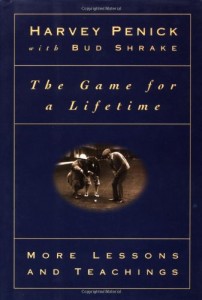Harvey Penick’s Little Book Series
The late Harvey Penick had a great reputation among professional golfers and others with experience in golf instruction.
A quiet, reserved gentleman, he had a long, distinguished career as a club pro and instructor in Austin, Texas. Tom Kite and Ben Crenshaw were among his well-known PGA students, and Kathy Whitworth, Betsy Rawls, and Mickey Wright of the LPGA.
In the twilight of his career, Mr. Penick decided to publish his collection of teaching notes and pointers he developed over his long career. Bud Shrake, a Sports Illustrated reporter and sports columnist, worked with him to prepare his collection for publication.
The Little Red Book succeeded commercially beyond all expectations, and for good reason.
With its pithy suggestions, parables from the success of his successful students, and simple good sense, the book struck a chord with the golfing audience.
Since its original publication, Mr. Penick published more books expanding on his themes.
And If You Play Golf (The Green Book) is the second book in the series.
The third book had a blue cover, and continued with more gentle instruction–The Game for a Lifetime: More Lessons and Teachings.
Since Mr. Penick’s death, Bud Shrake and Edwin Shrake compiled what they considered the best of The Little Red Book, And If You Play Golf, and the other books into The Wisdom of Harvey Penick.
Although it’s a nice edition itself, I still recommend you begin with the two original books. As you read The Red Book, you can hear Mr. Penick speaking in a soothing, gentle voice. The lessons he imparts are a great help to the average golfer.
For example, to help generate a smooth swing, he suggests thinking about clipping the tee on the downswing. Not only does this help with tempo, it breaks the habits of those who find themselves ball-bound, with all the bad side effects that habit can produce.
In The Green Book, he explains why he always insisted that children be told to finish the hole completely. It is the best way they will learn to putt well under pressure. That’s a good point that many adult players should keep in mind, also.
Club tournaments often show the effects of too many gimmes, don’t they?
Mr. Penick stresses the benefits of simplicity throughout the game. He also understood that the proper approach to the game also assists in achieving the proper approach to life:
Life consists of a lot of minor annoyances and few matters of real consequence. . . . Try and be simple in living as well as in teaching or playing. The long odds are against us if we shoot the hard way.
It’s a good thing for the rest of us that Mr. Penick decided to share his thoughts from a lifetime of teaching. These books will eventually be recognized as among the few classics in golf instruction.
Review Date: August 12, 1998





